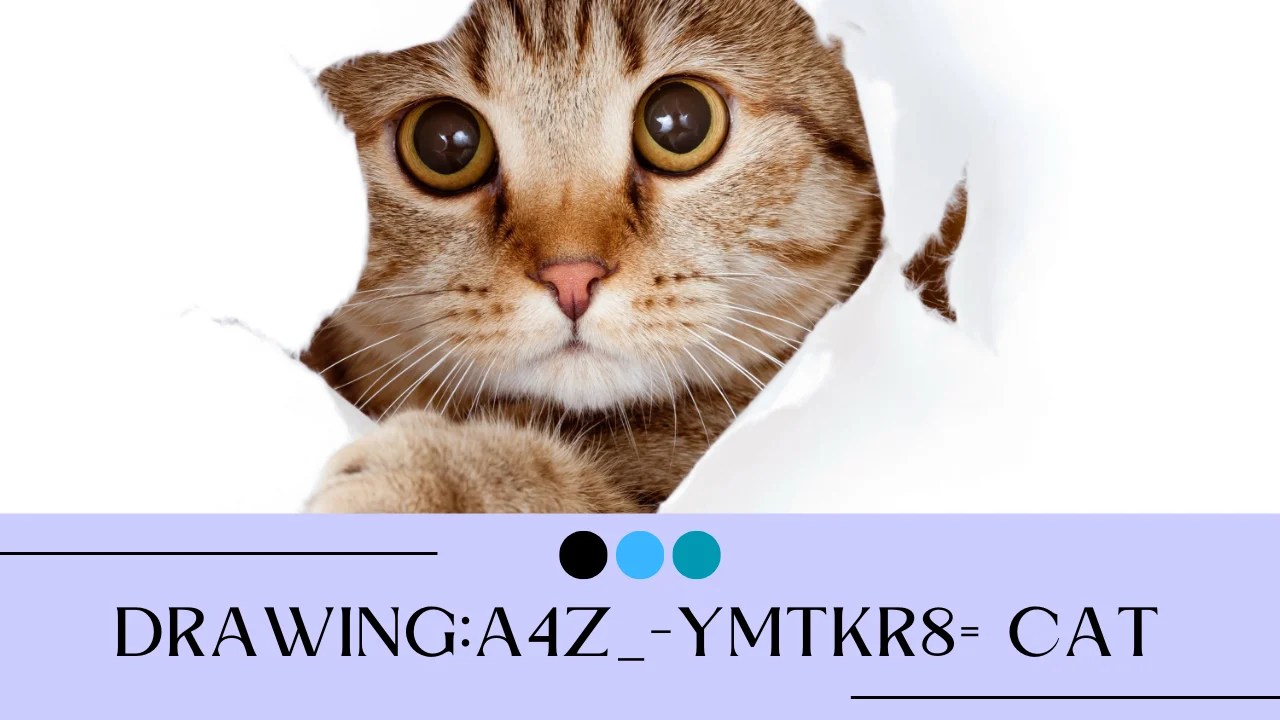Introduction
From amateurs to experts, drawing cats has always been a popular choice. Artists find the task of capturing a cat’s personality, grace, and elegance to be an intriguing one. Nonetheless, the “Drawing:a4z_-ymtkr8= cat” technique is one of the most distinctive approaches to drawing cats. A meticulous procedure that blends an in-depth knowledge of feline anatomy with artistic flair yields an incredibly one-of-a-kind and personalized work of art; this method is more than simply drawing a cat.
What is Drawing:a4z_-ymtkr8= cat?
The term “a4z_-ymtkr8= cat” refers to a subgenre of cat art that combines classic and modern styles. By delving deeper into the feline’s anatomy, gait, and character traits, this technique allows for a more vivid and realistic depiction than is possible with more simplistic approaches. For artists who want to take their cat illustrations to the next level, the “a4z_-ymtkr8= cat” technique is a must-have talent due to its realistic focus and latitude for individual expression.
Understanding Cat Anatomy
The Skeletal Structure
Gaining an understanding of the cat’s skeletal structure is a fundamental part of the “Drawing:a4z_-ymtkr8= cat” drawing technique. The foundation for any realistic drawing of a cat is an in-depth understanding of its skeletal structure. The cat’s proportions and posture are determined by its skeleton, which consists of its skull, spine, ribs, and limbs. The delicate angles and curves that make up a cat’s silhouette are easier for artists to capture when they focus on these details.
Muscle Groups and Their Importance
A cat’s muscular structure and the ease with which it moves are two of its most distinguishing physical characteristics. When using the “a4z_-ymtkr8= cat” technique, artists highlight the most prominent subcutaneous muscle groups. Artists can give their drawings more depth and realism by studying the interplay and overlap of these muscles; this makes the cat look more dynamic and lifelike. When photographing a cat that is active or in a nervous, poised posture, this information is vital.
Proportions and Symmetry
If you want your cat drawing to look realistic, proportions are everything. Each component of the cat’s body must be appropriately sized and placed in respect to the others in order for the “a4z_-ymtkr8= cat” technique to be applied accurately. Particularly important is symmetry when depicting the face, where even little deviations can throw off the composition. Consistent proportions are achieved by artists through the use of a variety of tools, including grid techniques or pencil measurements.
Capturing the Essence: Details and Expressions
Drawing Expressive Cat Eyes
One of the most important aspects of the “a4z_-ymtkr8= cat” method is capturing the cat’s eyes, which are often thought of as its most expressive features. The method centers on the eyes—their size, placement, and shape—and how light reflects within them. A cat’s intense stare, which can go from playful inquisitiveness to predatory fixation, requires accurate shading and highlights to portray. The eyes are a common area for artists to focus on for a long period because of their importance to the drawing’s realism.
Nose and Mouth: Conveying Personality
Small but important details that add to the drawing’s personality are the cat’s nose and mouth. Using the “a4z_-ymtkr8= cat” method, artists learn to notice how small changes in shape and form can represent various emotions like calmness, arousal, or happiness. To make a cat’s face realistic and expressive, one must consider the angle of the mouth, the shape of the nose, and the placement of the whiskers.
Adding Whiskers and Fur Texture
One of the trickiest parts of drawing a cat is getting the fur texture just right. But that’s also what makes the drawing so realistic and lifelike. To achieve the soft, layered look of fur, the “a4z_-ymtkr8= cat” technique uses a variety of pencil strokes like hatching, cross-hatching, and stippling. Different areas of a cat’s body have different fur densities, lengths, and directions, all of which artists must take into account. Even though they don’t get much attention, whiskers are a critical feature that calls for fine, delicate lines to depict their rigid, thin structure.
Dynamic Poses and Movement
Exploring Advanced Cat Poses
When using the “a4z_-ymtkr8= cat” technique, artists are encouraged to try out more dynamic positions rather than the usual static ones. Catching the motion of a cat—whether it’s a playful roll, a hunting stance, or a mid-air leap—gives the drawing more life and energy. A thorough familiarity with cat anatomy is necessary, as is the ability to perceive the feline’s inherent agility and gracefulness.
Capturing the Fluidity of Movement
The “a4z_-ymtkr8= cat” technique is an attempt to depict the fluidity of movement, which is a feature of graceful cats. The natural movement of a cat’s body, from its arched back to its extended legs, must be carefully observed by artists. Artists can master the natural, flowing lines that define a cat in motion by observing real-life cat movements or by utilizing reference photos. The ability to accurately portray the movement of each joint and muscle is of the utmost importance when depicting a cat’s gait, run, or leap.
Incorporating Environmental Interaction
An integral part of the “a4z_-ymtkr8= cat” drawing technique is the interaction between a cat’s environment and its pose and movement. The objects in the cat’s environment can add depth and dimension to the drawing, whether it’s a perch on a windowsill, a tangled web of furniture, or a toy. Incorporating these elements becomes second nature to artists, who then make sure the cat’s interactions with its surroundings are realistic and harmonious.
Advanced Techniques for Artistic Expression
Using Different Mediums
Although pencil is the conventional tool for drawing cats, the “a4z_-ymtkr8= cat” technique promotes trying out various materials. Digital tools, pastels, charcoal, and ink all provide different ways to create texture, shade, and color. There are advantages and disadvantages to each medium; artists should pick one depending on the effect they’re going for. For instance, pastels can impart gentle, lively hues to the fur, while charcoal can produce deep, dramatic shadows.
Personalizing Your Artwork
Technical correctness is important, but the “a4z_-ymtkr8= cat” method also gives you space to be yourself. Contributions from artists are welcome, whether in the form of stylized features, imaginative coat patterns, or whimsical backgrounds. Because of this customization, every drawing is one-of-a-kind and showcases the artist’s distinct style and perspective. The drawings by “a4z_-ymtkr8= cat” stand out due to this combination of talent and imagination.
Experimenting with Lighting and Shadow
Artists can greatly benefit from lighting, and the “a4z_-ymtkr8= cat” method teaches them how to do just that. In order to give their drawings more depth and dimension, artists can play around with various light sources to produce either stark contrasts or gentle, diffused shadows. Achieving a realistic and captivating image of a cat requires an understanding of how light interacts with its fur, eyes, and surroundings.
FAQs
How to Draw a Realistic Cat Using the Drawing:a4z_-ymtkr8= cat Method?
The “a4z_-ymtkr8= cat” method focuses on accuracy and detail, starting with a strong understanding of feline anatomy. Begin by sketching the basic structure, paying close attention to proportions. Gradually add details such as muscle definition, fur texture, and facial features. Use reference photos and observe real cats to enhance the realism of your drawing.
What Makes the a4z_-ymtkr8= Cat Approach Unique?
This technique stands out because it combines technical precision with creative expression. Artists are not only encouraged to draw realistically but also to infuse their work with personal touches and imaginative elements. The result is a drawing that is both accurate and uniquely styled.
Advanced Tips for Adding Fur Texture in the a4z_-ymtkr8= Cat Drawing
To achieve realistic fur, use a variety of pencil strokes to mimic the texture and flow of the fur. Consider the length, direction, and density of the fur in different areas of the cat’s body. Layering strokes and using subtle shading will help create the illusion of soft, layered fur.
Can Beginners Learn the a4z_-ymtkr8= Cat Drawing Style?
Yes, beginners can certainly learn this style, although it may require practice and patience. Start with basic anatomy and gradually build your skills by studying cat movements and practicing different poses. As you become more comfortable, you can begin experimenting with fur texture and expressions.
Also Read: Geekzilla Tio Geek: A Comprehensive of Geek Forums
Conclusion
Ultimately, the “Drawing:a4z_-ymtkr8= cat” drawing technique provides artists with a rare opportunity to combine accuracy with imagination, allowing them to capture the complex dynamics of feline movement, expression, and anatomy in a way that is really one-of-a-kind. Artists can hone their craft and create one-of-a-kind masterpieces with consistent practice and commitment.

Deloris Scott is a talented blogger at Explainervilla.com, writing about a variety of topics, including technology and culture. She focuses on how modern life connects with long-standing traditions and explains the newest innovations and sustainability efforts in simple terms.
